This was published 5 years ago
Hawaii's Volcanoes National Park with active volcano Kilauea reopens, new coastline created
By Julie Miller
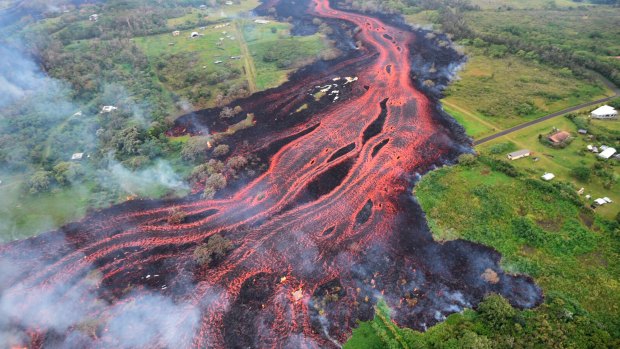
Lava flows from fissures near Pahoa, Hawaii, on May 19, 2018.Credit: AP
After four months of destructive rampage, the capricious volcano goddess Pelehonuamea is taking a well-earned break. An eerie calm has descended on Kilauea on the island of Hawai'i; the molten lava oozing from fissures that appeared after a major earthquake and eruption in May have dried up, and seismic activity has subsided to the odd rumble.
And while Pele – or "she who shapes the sacred land" – slumbers, her human admirers can return to observe her handiwork. Closed since May 11, 2018, Hawai'i Volcanoes National Park is due to reopen to the public on September 22, allowing visitors limited access to the caldera and trails now considered safe.
Those expecting hellfire visions of spluttering lava fountains or apocalyptic rivers of fire may well be disappointed, however – there is currently no molten lava visible anywhere in the park, with the lava lake inside the crater disappearing after the recent eruption and the viscous flows from Pu'u 'O'o cone, which had been erupting almost continuously since 1983, also petering out.
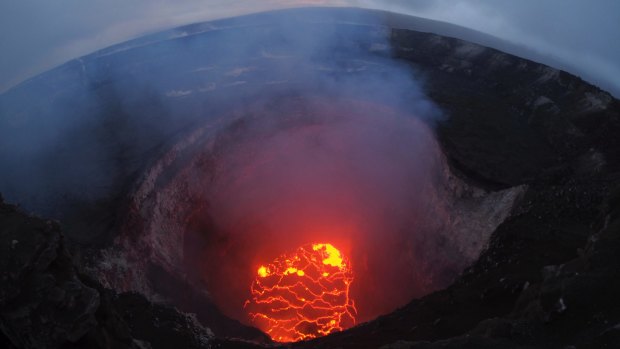
Tthe lava lake inside Kilauea volcano has now disappeared following the eruptions in May.Credit: U.S. Geological Survey/AP
What visitors will see, however, is the wonder of creation. On a helicopter joyflight above Kapoho Bay, on the eastern tip of the Big Island (as the island of Hawai'i is commonly known), we stare in amazement at 280 hectares of new land, the youngest part of our planet created when lava cascaded into the sea after swallowing more than 700 homes, covering the highway and displacing thousands of residents.
From the air, the randomness of nature's destruction is sobering; bare, black fields of hardening rock slice through patches of lush tropical jungle, dotted with houses untouched by Pele's fiery hand but since abandoned, their owners unable to return any time in the foreseeable future.
On a ridge, the green roofs of the Puna Geothermal Power plant are all intact, with the facility miraculously avoiding loss as lava from Fissures 7 and 22 crossed paths. Further west, the cone of Fissure 8, which at the height of the eruption spewed lava as high as 60 metres into the air, has been reduced to a series of steam vents, its lava pond now just a cavernous black hole.
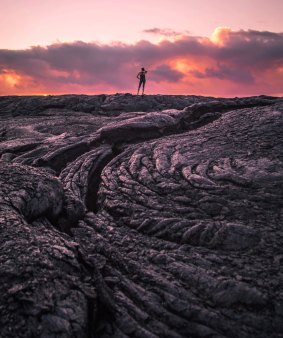
Lava field at sunset, Hawaii Volcanoes National Park.
During our 45-minute flight with Blue Hawaiian Helicopters to what's known as the Circle of Fire, our pilot Ester sweeps over these sights several times, allowing passengers on either side to take photos. She also recalls how the birds-eye view has changed over the past few months, from the drama of the early eruption, to the incredible sight of braided rivers of fire pouring into the sea, creating clouds of noxious "laze gas".
Since May 3, Kilauea has produced more than 110 million cubic metres of lava – enough to fill 45,000 Olympic-sized swimming pools and cover the island of Manhattan to a depth of two metres.
Meanwhile, the summit of the volcano has also dramatically changed, with tens of thousands of earthquakes causing massive land collapses, rock falls and cracks in roads, trails and other National Park infrastructure. While much of the damage has been repaired, parts of the park are still unstable and will remain closed, with authorities issuing a new map advising visitors where they can safely go.
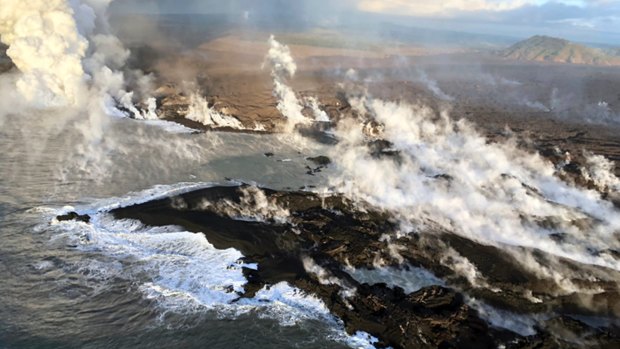
New land formed by lava from Kilauea Volcano where the bay and village of Kapoho once stood on the island of Hawaii.Credit: AP
"Hawaiʻi Volcanoes National Park is a wild place," the Special Reopening Advisory states. "The dramatic landscape of Kilauea is constantly being shaped by powerful and uncontrollable natural forces. Respect the dangers of this dynamic natural process and stay out of closed areas."
Park authorities also warn that visitor services will be limited after reopening, and that no drinking water will be available. They also foresee parking issues, as well as long queues as curious visitors flock to pay their respects to Madame Pele.
Interestingly, air quality at the caldera – and even beyond on the Kona coast – is good, with sulphur dioxide levels at their lowest recorded levels since 2007. During the eruption, "vog" – or volcanic fog – often wafted over to Kailua-Kona, creating gloomy, Beijing-like skies; currently, locals are revelling in dazzling blue-sky conditions, boasting that their beachside resort has never looked better.
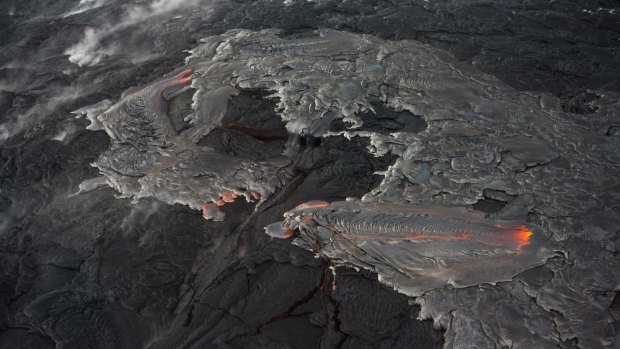
Lava Flow from Puuoo.
Immediately following the May eruption, tourism to the Big Island plummeted by 50 per cent, costing the local economy millions of dollars. But while overall numbers were down, some attractions – such as horseback rides in the northern Waipio Valley – actually saw an increase in business as tourists sought alternatives to volcano-watching.
For such is Madame Pele's way – she devours the land, but also opens the path to creation.
FIVE OTHER ATTRACTIONS ON THE BIG ISLAND
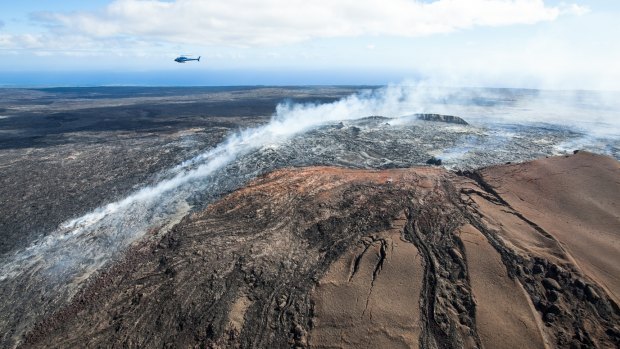
Helicopter tour flies over lava flow, Hawaii Island.
Visit the Valley of Kings: Located on the lush northern tip of the island of Hawai'i, the verdant Waipio Valley was once home to Hawaiian royal families, a naturally-fortified stronghold framed by a black sand beach and soaring 700-metre cliffs, twin waterfalls tumbling into the abyss. After a rather terrifying descent into the valley via four-wheel drive, you can explore the sodden valley floor on a three-hour guided horse trek with Waipio on Horseback. See waipioonhorseback.com
Swim with Mantas: When the Sheraton Kona Resort & Spa was built 40 years ago, they accidentally created a tourist attraction by installing powerful lights illuminating Keauhou Bay. As plankton are drawn to the beam, so too is a resident family of hungry manta rays, who put on a nightly show for crowds gathered at the hotel's restaurant and bar. You can also snorkel with the majestic giants on various tours and sunset cruises. See sheratonkona.com
Drink Kona coffee: Coffee lovers rejoice – there is palatable coffee in the United States! Coffee has been grown on the slopes of Hualalai since 1828, and is now a highly prized, flavoursome drop. Today, there are around 650 farms in the Kona district, with the beans handpicked and produced. One of the original coffee growers, Greenwell Farms, also offers tours of its facility. See greenwellfarms.com
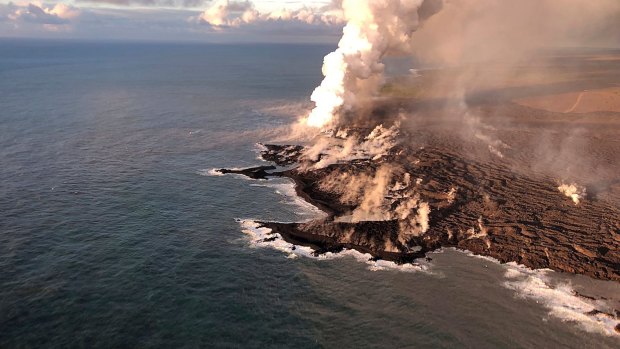
Lava from Kilauea Volcano enters the ocean, with a resulting laze plume, at Kapoho on the island of Hawaii.Credit: AP
Ride with the Paniolo: The northern Waimea region of the Big Island boasts one of the oldest and largest cattle ranches in the world (Parker Ranch), staffed by "paniolo'' cowboys who trace their roots to Mexican vaquero who were brought to the island in 1832 to work cattle. You can see the cowboys in action at the July 4 Parker Ranch Rodeo, or explore the open range on horseback with Paniolo Adventures. See panioloadventures.com
Enjoy the beaches: Not only does the Big Island boast beautiful white sand beaches, but it also has distinctive black and even a green sand beach, created from olivines green crystals. The most popular beaches for swimming and snorkelling are on the Kona "Gold Coast"; there are also many "secret" beaches only accessible by 4WD. Honolii, north of Hilo on the east coast, is a renowned surfing spot, featuring powerful waves during the winter months.
TRIP NOTES
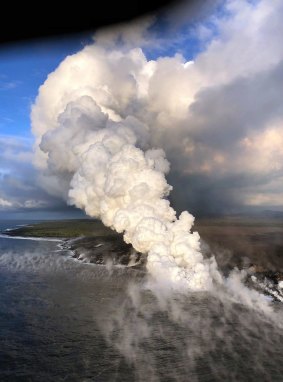
Steam and ash rising from new land formed by lava from Kilauea Volcano.Credit: AP
The writer travelled as a guest of Hawaii Tourism.
FLY
Hawaiian Airlines (www.hawaiianairlines.com.au ) and Qantas (www.qantas.com.au ) operate daily flights from Sydney to Honolulu, with domestic transfers to Hilo or Kona with Hawaiian Airlines.
STAY
Sheraton Kona Resort & Spa has rooms starting from $US169 plus tax, see www.sheratonkona.com
Sign up for the Traveller Deals newsletter
Get exclusive travel deals delivered straight to your inbox. Sign up now.